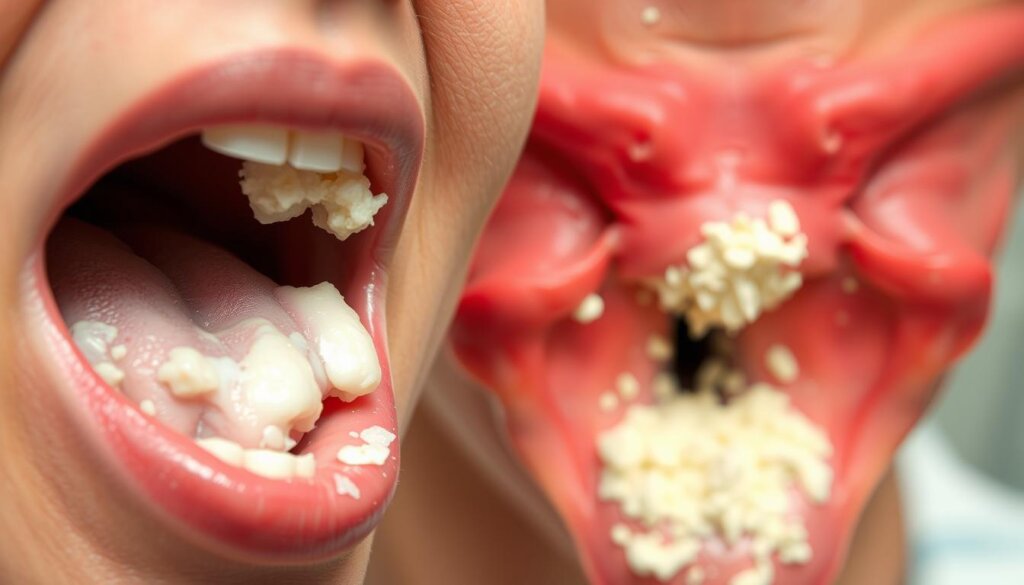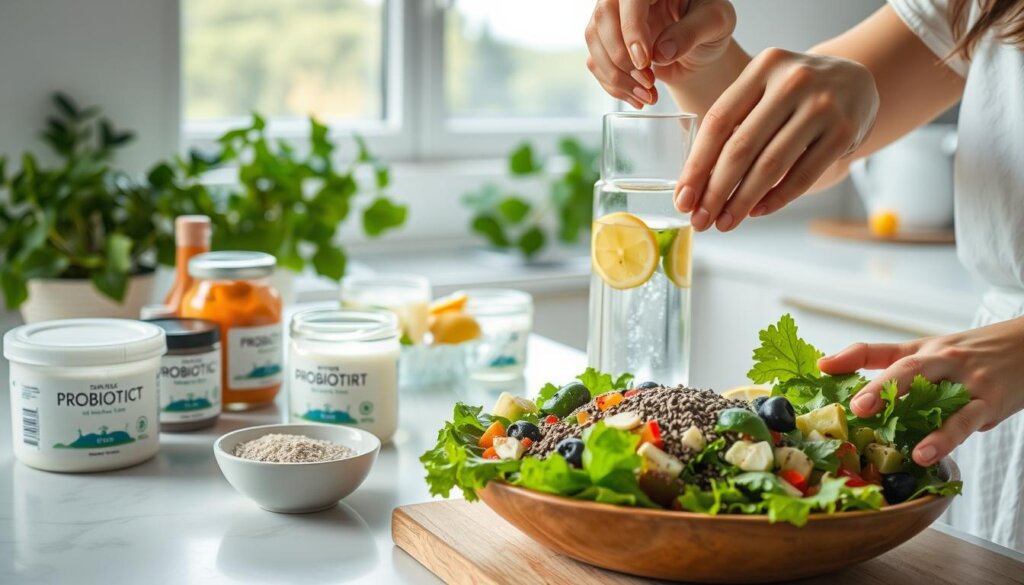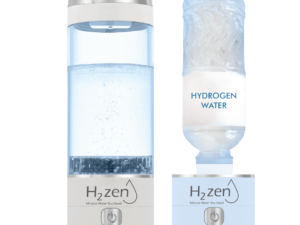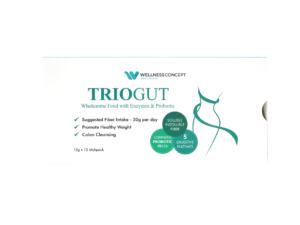What if balancing your body’s natural ecosystem could help manage a common yet uncomfortable condition? Many people experience yeast infections like thrush, often caused by an overgrowth of Candida albicans. This fungus exists harmlessly in areas like the mouth and gut—until imbalances trigger issues. Wellness Group, Malaysia’s trusted health partner, explores how restoring microbial harmony might support wellness.
Thrush affects millions globally, yet few discuss it openly. Discomfort shouldn’t mean shame. Modern approaches increasingly prioritize gentle, evidence-backed strategies over harsh treatments. Research shows that supporting beneficial bacteria could play a role in maintaining balance.
This guide simplifies complex science into actionable steps. Readers will learn about causes, symptoms, and prevention—all through a natural lens. Wellness Group combines expertise with compassion, offering reliable resources for those seeking holistic care.
Key Takeaways
- Thrush stems from Candida overgrowth, often linked to bacterial imbalances
- Natural approaches are gaining medical recognition for yeast infection management
- Wellness Group provides Malaysia-focused guidance for holistic health solutions
- Understanding triggers helps in choosing effective treatment paths
- Prevention strategies can reduce recurrence risks through simple daily habits
Introduction to Thrush and Vaginal Yeast Infections
Our bodies host diverse microbial communities working in harmony—until something tips the scales. One frequent disruptor is Candida albicans, a type of fungus naturally present in moist areas like the mouth and vagina. Normally kept in check by beneficial bacteria, this microbe can multiply rapidly when the body’s balance falters.
When Harmony Becomes Overgrowth
Vaginal yeast infections affect 3 out of 4 women globally, with many experiencing recurrences. These aren’t failures of self-care but natural responses to changes in pH levels or bacterial populations. Common triggers include antibiotics, hormonal shifts, or even stress.
Recognizing the Signs
Two main forms exist: oral (white patches in the mouth) and vaginal (itching, unusual discharge). Both indicate microbial imbalance rather than contagion or poor hygiene. As one Malaysian health practitioner notes: “These conditions whisper when our body’s ecosystem needs attention.”
Local climate and lifestyle factors in Southeast Asia can influence susceptibility. The key lies in understanding that occasional flare-ups don’t define health—they’re reminders to support our body’s natural defenses through informed choices.
Causes and Risk Factors of Yeast Infections
Understanding why these issues develop helps manage them effectively. Multiple factors—from daily habits to underlying health conditions—can tip the body’s delicate balance.
Medical and Lifestyle Contributors
Antibiotics often unintentionally clear protective bacteria, letting Candida flourish. Hormonal shifts during pregnancy or from birth control pills create sugar-rich environments where yeast thrives. Medications like corticosteroids or immunosuppressants may weaken defenses against microbial imbalances.
Chronic health issues play a role too. Poorly managed diabetes elevates blood sugar levels, feeding fungal growth. Stress and malnutrition further strain the body’s ability to maintain equilibrium.
Daily choices matter. Tight synthetic clothing traps moisture, while diets high in refined sugars provide fuel for yeast infections. Smoking and inadequate hygiene practices add to the risks, especially in humid climates like Malaysia’s.
How Disruptions in Your Microbiota Occur
The body relies on beneficial bacteria to keep pathogens in check. When this microbial network weakens—due to illness, medications, or lifestyle factors—harmful organisms like Candida seize the opportunity to multiply.
Recognizing these triggers isn’t about blame but empowerment. Simple adjustments, like choosing breathable fabrics or discussing medication alternatives with a doctor, can significantly reduce recurrence risks. Knowledge transforms worry into actionable steps toward lasting wellness.
How to Recognize Oral and Vaginal Thrush
Knowing what to look for empowers you to take control of your health. While both forms share similarities, their symptoms manifest differently. Early identification helps prevent complications and guides effective care choices.

Identifying Oral Indicators
White patches on the tongue or inner cheeks often signal oral issues. These lesions might bleed when scraped and leave a cotton-like feeling. Some people report a metallic taste or persistent dryness that makes swallowing uncomfortable.
Cracks at the corners of the mouth frequently accompany these changes. A burning sensation while eating acidic foods could also indicate imbalance. If these symptoms last over a week, consult a healthcare provider.
Spotting Vaginal Changes
Vaginal health shifts often announce themselves through texture and discomfort. A thick, clumpy discharge resembling cottage cheese is a hallmark sign. Intense itching around the vulva typically follows, sometimes with visible redness.
Pain during urination or intimacy often develops as inflammation increases. These symptoms vaginal infections cause can disrupt daily life if left unaddressed. As one Kuala Lumpur nurse advises: “Don’t dismiss recurring irritation—it’s your body requesting support.”
While these patterns help identify common cases, some symptoms overlap with other conditions. Testing ensures accurate diagnosis—especially if discharge appears yellow-green or carries a strong odor. Quick action prevents minor issues from becoming persistent problems.
Probiotics for Thrush: Natural Solutions
Science reveals how beneficial microbes act as nature’s peacekeepers in microbial ecosystems. These live microorganisms help restore balance where harmful organisms threaten to dominate. When imbalances occur, specific bacterial allies step forward to reclaim territory.
Why Specific Lactobacillus Strains Matter
Certain bacterial varieties naturally dominate healthy environments. Lactobacillus species thrive in balanced systems, crowding out unwanted guests through strategic teamwork. Their presence creates conditions where invaders struggle to gain footing.
These microbial defenders work through multiple clever tactics. They produce lactic acid, maintaining slightly acidic environments that discourage yeast overgrowth. Simultaneously, they release compounds that directly inhibit unwanted organisms’ growth.
Research highlights their competitive edge. A 2022 clinical trial showed certain strains reduced recurring vaginal yeast issues by 47% compared to placebos. By occupying prime real estate on mucosal surfaces, they physically block harmful colonization.
The immune system benefits from this alliance too. Friendly bacteria train defense cells to recognize threats faster. One study noted improved immune responses against yeast in participants using targeted supplements.
Choosing the right microbial partners makes all the difference. Look for products containing clinically tested strains like L. rhamnosus GR-1 or L. reuteri RC-14. These have demonstrated effectiveness in maintaining harmony during vaginal yeast challenges.
Emerging evidence supports combining these approaches with traditional care. As science evolves, nature-inspired solutions offer promising paths for those seeking gentler, sustainable strategies.
Step-by-Step Guide: Using Probiotics for Prevention and Treatment
Taking charge of wellness begins with smart product selection and proper application techniques. The right approach helps maintain balance while offering gentle support during challenging times.
Choosing Your Microbial Partners
Quality matters when selecting microbial supplements. Look for these features:
| Form | Key Features | Timeframe | Usage Tips |
|---|---|---|---|
| Capsules | 1010-1011 CFU, L. rhamnosus strains | 1-4 weeks | Take with meals |
| Suppositories | Localized action, 107 CFU | 3-7 days | Use before bedtime |
| Yogurt Mix | Plain yogurt + raw honey | 5-10 days | Apply with clean tampon |
Application Strategies and Timing
Consistency drives results. Oral options work gradually—allow 2-3 weeks for full effects. For immediate relief, suppositories or yogurt applications show changes within days.
Combine methods when needed. Many women pair morning capsules with evening topical microbial allies during flare-ups. Always finish treatment cycles even if symptoms improve earlier.
Track progress weekly. If no improvement occurs after 14 days, consult a healthcare provider. Some find combining these approaches with prescribed antifungals speeds recovery.
Lifestyle Changes and Additional Prevention Strategies

Daily choices shape our body’s defenses in surprising ways. Simple adjustments create environments where beneficial microbes thrive while discouraging unwanted guests. Let’s explore practical steps that work with your natural rhythms.
Fueling Defense Through Daily Habits
What you eat directly impacts microbial balance. Reducing sugary snacks starves yeast by cutting off their favorite food source. Focus on fiber-rich vegetables and fermented foods to nourish your gut ecosystem. As one nutritionist puts it: “A vibrant plate builds resilient defenses.”
Clothing choices matter more than many realize. Tight synthetic fabrics trap moisture—a perfect breeding ground. Opt for breathable cotton underwear and loose-fitting outfits that let skin breathe. Change swimsuits or workout clothes promptly after use.
Gentle hygiene maintains balance without disruption:
- Use pH-balanced cleansers instead of harsh soaps
- Always wipe front to back after using the toilet
- Avoid scented sprays or douches that disturb natural acidity
Recognizing When Help Is Needed
While lifestyle changes help many, some conditions require professional guidance. Seek medical advice if:
- Symptoms persist after 7 days of counter measures
- You experience recurrent episodes (4+ yearly)
- Underlying health issues like diabetes complicate recovery
Your body communicates clearly—recurring discomfort signals deeper imbalances. Modern healthcare combines lifestyle wisdom with clinical expertise for lasting solutions. Remember, seeking help isn’t defeat; it’s smart strategy.
Conventional Treatments and Complementary Approaches
Modern medicine offers effective tools to combat stubborn yeast issues while supporting the body’s natural defenses. Combining clinical expertise with holistic strategies often yields better long-term results than standalone approaches.
Antifungal Medications and Their Use
Antifungal medication remains the frontline defense against active infection. These treatments work by disrupting fungal cell membranes, stopping Candida overgrowth. Options include creams, vaginal suppositories, or oral pills like fluconazole—typically used for 1-14 days depending on severity.
A 2015 clinical trial revealed combining prescription antifungal medication with targeted microbial support boosted effectiveness by 34%. Participants experienced fewer recurrent candidiasis cases compared to those using antifungals alone.
Completing the full course of medication is crucial, even if symptoms fade early. Stopping prematurely risks creating drug-resistant infection strains. Many healthcare providers recommend starting probiotics 24 hours after antifungal treatments to replenish beneficial bacteria without interference.
While these candidiasis solutions work quickly, they’re most effective alongside preventive habits. Seek medical guidance if symptoms persist beyond a week or recur frequently—this could signal underlying conditions needing specialized care. As one Kuala Lumpur gynecologist notes: “Smart integration of approaches builds lasting resilience against microbial imbalances.”
How Wellness Group Supports Your Health Journey
Navigating health challenges becomes easier with the right support system. Wellness Group stands as Malaysia’s trusted partner in natural wellness, offering tailored strategies for managing microbial imbalances. Their team combines clinical knowledge with compassionate care to address various health concerns effectively.
Expert Guidance at Your Fingertips
Clients access professional advice through convenient channels like WhatsApp (+60123822655). This service helps individuals choose solutions suited to their unique health needs. Whether managing recurrent vulvovaginal candidiasis or seeking preventive strategies, personalized recommendations await.
Your Time, Their Priority
Wellness Group’s schedule adapts to busy Malaysian lifestyles:
| Days | Hours |
|---|---|
| Weekdays | 9:30 AM – 6:30 PM |
| Saturday | 10 AM – 5 PM |
| Sunday | Closed |
Their approach considers multiple factors—from system imbalances to lifestyle preferences. One team member shares: “We map out strategies that respect each person’s daily rhythm while targeting root causes.”
By blending conventional wisdom with natural benefits, they help clients tackle different types of yeast-related concerns. Education remains central—understanding why certain methods work empowers lasting change.
For those dealing with persistent vulvovaginal candidiasis or other yeast imbalances, this team provides ongoing support. Their commitment shines through quality products and evidence-based guidance tailored for Malaysia’s unique health landscape.
Conclusion
Taking control of microbial balance transforms how we approach intimate health. Research confirms specific Lactobacillus strains help maintain environments where vaginal candida struggles to dominate. Studies reviewing natural approaches show reduced recurrence rates for those managing recurrent vulvovaginal candidiasis.
Simple daily choices create lasting change. Cotton underwear, pH-friendly products, and reduced sugar intake support the body’s defenses against yeast overgrowth. Combining these habits with targeted microbial allies offers a dual strategy for prevention and care.
Medical reviews emphasize that persistent infections often signal deeper imbalances. Wellness Group’s Malaysia-focused guidance helps individuals navigate options confidently. Their team blends clinical insights with practical lifestyle adjustments tailored to tropical climates.
Ready to reclaim comfort? Start by reviewing daily routines and exploring science-backed solutions. For personalized support managing vaginal candida or recurrent vulvovaginal candidiasis, connect with Wellness Group’s experts today. Small steps today build healthier tomorrows.
FAQ
What are the common signs of vaginal yeast infections?
Vaginal yeast infections often cause itching, redness, and a thick, white discharge resembling cottage cheese. Some may experience discomfort during urination or intercourse. These symptoms are typically linked to an overgrowth of Candida albicans.
Can lifestyle changes help prevent recurrent vulvovaginal candidiasis?
Yes! Wearing breathable cotton clothing, avoiding scented hygiene products, and maintaining a balanced diet low in sugar can reduce risk. Staying dry and practicing good hygiene also supports a healthy vaginal environment.
How do Lactobacillus strains combat candida overgrowth?
Specific strains like Lactobacillus rhamnosus and Lactobacillus reuteri produce lactic acid, which lowers vaginal pH. This creates an inhospitable environment for harmful fungi while promoting beneficial bacteria.
Are antifungal medications safer than natural remedies?
Antifungal treatments like fluconazole are effective for acute cases but may disrupt natural microbiota with frequent use. Combining them with natural approaches, such as targeted supplements, can offer a balanced strategy for long-term health.
When should someone consult a doctor about recurring infections?
If symptoms persist beyond seven days, occur more than four times a year, or include fever or unusual discharge, seek medical advice. Pregnant individuals or those with weakened immune systems should prioritize professional care.
How does Wellness Group assist in managing these conditions?
Wellness Group provides personalized guidance, including product recommendations and lifestyle tips tailored to individual needs. Reach out via WhatsApp at +60123822655 during business hours for support in Malaysia.






